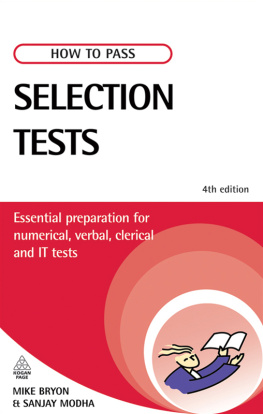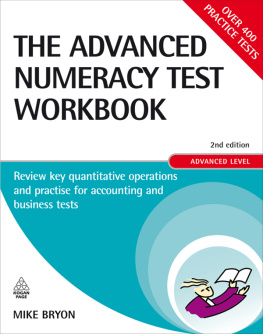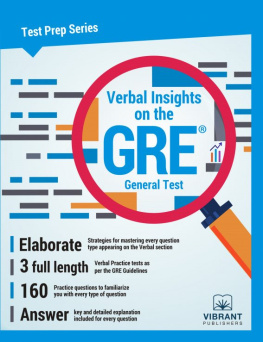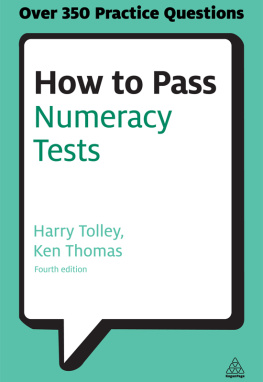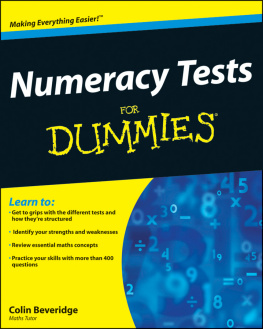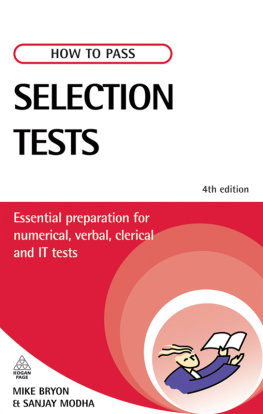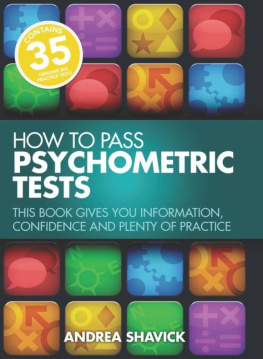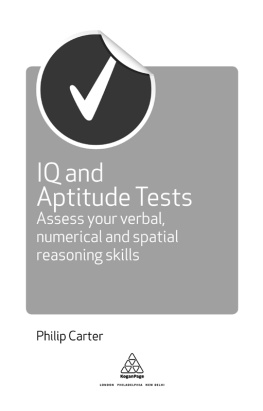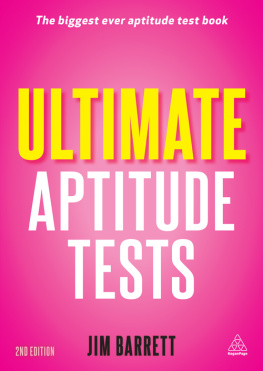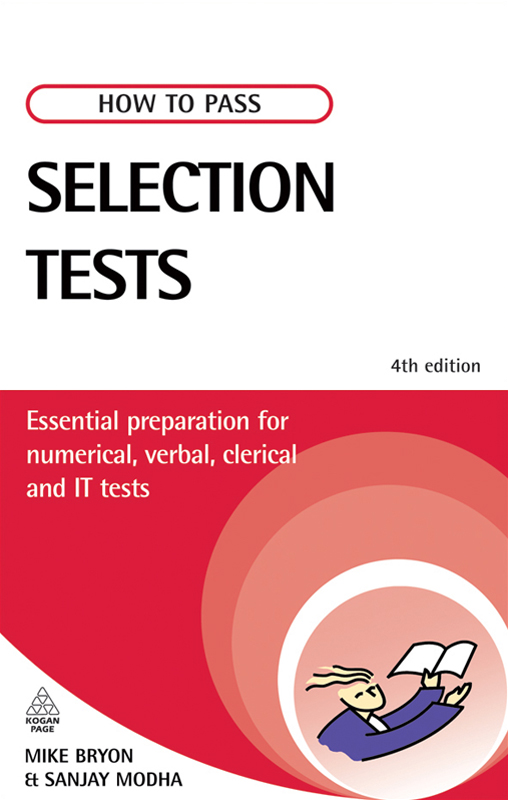We dedicate this book to Nima Modha-Bhatti and Ella Schlesinger
SELECTION
TESTS
Essential preparation for numerical,
verbal, clerical and IT tests
4th edition
MIKE BRYON
& SANJAY MODHA
Publishers note
Every possible effort has been made to ensure that the information contained in this book is accurate at the time of going to press, and the publishers and authors cannot accept responsibility for any errors or omissions, however caused. No responsibility for loss or damage occasioned to any person acting, or refraining from action, as a result of the material in this publication can be accepted by the editor, the publisher or any of the authors.
First published in 1991
Revised edition 1992
Title changed to How to Pass Selection Tests in 1994
Second edition 1998
Third edition 2005
Fourth edition 2010
Apart from any fair dealing for the purposes of research or private study, or criticism or review, as permitted under the Copyright, Designs and Patents Act 1988, this publication may only be reproduced, stored or transmitted, in any form or by any means, with the prior permission in writing of the publishers, or in the case of reprographic reproduction in accordance with the terms and licences issued by the CLA. Enquiries concerning reproduction outside these terms should be sent to the publishers at the undermentioned addresses:
Kogan Page Limited | Kogan Page US |
120 Pentonville Road | 525 South 4th Street, #241 |
London N1 9JN | Philadelphia PA 19147 |
United Kingdom | USA |
www.koganpage.com |
Mike Bryon and Sanjay Modha 1991, 1998, 2005, 2010
The right of Mike Bryon and Sanjay Modha to be identified as the authors of this work has been asserted by them in accordance with the Copyright, Designs and Patents Act 1988.
British Library Cataloguing-in-Publication Data
A CIP record for this book is available from the British Library.
ISBN 978 0 7494 5693 1
Library of Congress Cataloging-in-Publication Data
Bryon, Mike.
How to pass selection tests : essential preparation for numerical, verbal, clerical and IT tests / Mike Bryon, Sanjay Modha. 4th ed.
p. cm.
ISBN 978-0-7494-5693-1
1. Employment tests. I. Modha, Sanjay. II. Title.
HF5549.5.E5B78 2010
650.076--dc22
2009028926
Typeset by Saxon Graphics Ltd, Derby
Printed and bound in India by Replika Press Pvt Ltd
eBook by Graphicraft Limited, Hong Kong
Contents
In recent years there has been a huge increase in the use of selection tests. The increase has been particularly pronounced in the area of employment with many more employers now relying on a test to help them decide between candidates.
As well as becoming far more popular, the style and method of testing has also changed. In a test today the questions are more likely to describe work situations, and their relevance to the job will be much more obvious. Far more common are questions about your personality and preferred working style. A test these days may well be taken at a computer terminal although tests administrated with paper and pen are still very common.
Tests have changed over recent years but you still need to be well prepared to succeed. Lots of practice is essential if you are to show your full potential in a selection or psychometric tests and this is why this book is so valuable. It contains many hundreds of really relevant questions that will allow you to prepare for the most common tests in use today. If you are applying for work in an office environment, in business, finance, administration or media then you will find it essential preparation.
The Kogan Page testing series includes titles aimed at all levels and most areas of testing. This book is the ideal starting point for a candidate facing tests at the intermediate level. Recommended sources of further practice are also provided.
The idea for this book arose from our work in pre-employment training for some of the largest employers in the UK. Our work involved preparing people for the selection process of these organisations and the posts that they would go on to fill. This experience led us to conclude that many people who fail the tests could in fact pass them. What is required is that they come to terms with their anxieties and prepare well prior to the test.
The purpose of this book is to make available to a general readership the strategies developed while preparing candidates for the selection tests.
Since its publication in 1991, How to Pass Selection Tests has become a best-seller and proved of considerable help to thousands of people who face employers tests. This fourth edition ensures that the exercises continue to help candidates prepare for the challenge of selection tests.
Motivated candidates complain that they are unable to obtain sufficient practice material. In response to this we have added over 200 new practice questions and added explanations to some of the answers. You will find material relevant to the majority of tests in use today and by working through the book you will revise essential skills and competencies.
Together with the editors we have tried to ensure that there are no errors in this book. If you find one then please accept our apologies and be kind enough to inform us of it so that it can be removed from the next imprint.
If you are finding it difficult to locate practice questions relevant to the test you face then feel free to contact us through Kogan Page and if we know of a source then we will be happy to provide you with details.
Many companies and organisations use tests for selection purposes and for many people these tests represent a significant obstacle to obtaining the job or career of their choice. The aim of this book is to inform readers about these tests and provide exercises so that they can practise before sitting a test. Over half the book comprises exercises that are relevant to some of the most common types of selection test currently in use.
Practice can result in significant improvements in performance in most sorts of test. It also boosts confidence and helps individuals to cope with nervousness. It makes individuals less prone to mistakes and ensures that the test is approached proficiently.
Information is provided about the history and nature of tests, and explanations are offered about why companies use tests and what they believe can be concluded from the results. Advice is also given about what to do if you fail.
The first standardised test of ability was produced in France at the beginning of the last century by Binet. Initially, the tests were developed for use with children for diagnostic purposes. It was not until World War I that testing for adults really began. These tests proved to be valuable in selecting and allocating recruits for different types of work in the armed forces and also for identifying potential officers. During World War II further advances in selection methods were made. Once again, the tests proved to be valuable in allocating different people to a variety of jobs or trades at different levels or grades.

